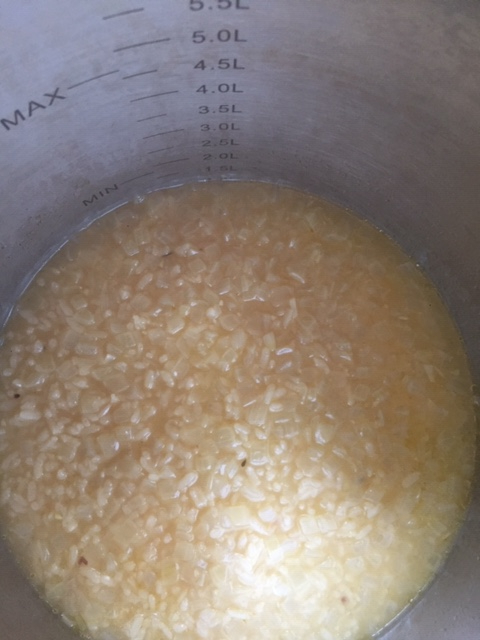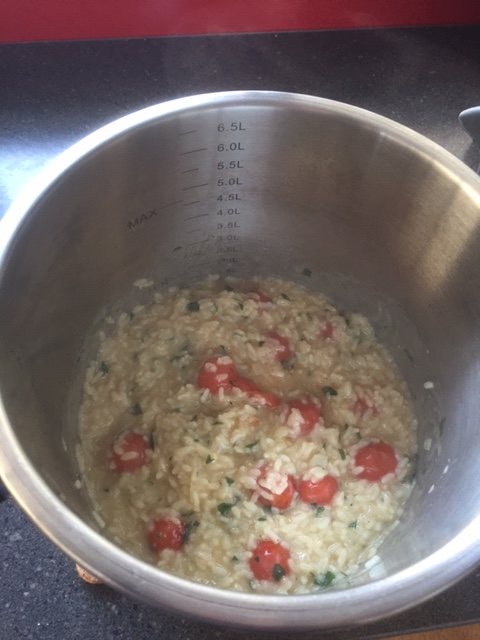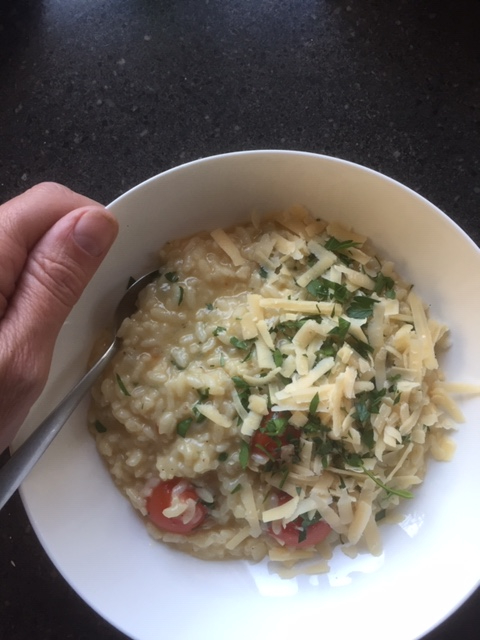Pressure Cooker Roast Tomato Risotto
Until the last couple of years I never really made risotto and was not overly keen on it, probably for several reasons. One was that I was not very good at it and never seemed to be able to get that nice risotto consistency and texture, nor had I had it anywhere else that convinced me it was worth my time investing in learning. It shouldn’t be hard to make but it’s not called the curse of the Masterchef kitchen for no reason. Another was who wants to spend 20 minutes or more continuously stirring stock into rice, especially if you’re pretty sure the end result won’t live up to expectations. But then two things happened for me – I had a risotto that convinced me to try again, and I discovered doing it in the pressure cooker.
For the first I got invited to a corporate shindig at the Adelaide zoo. It was a stand-up affair with drinks and food and at one point they brought around small bowls of a three cheese risotto. It was magnificent, with a taste and more importantly a texture that I hadn’t encountered with risotto previously.
 Cook the
onion and garlic and stir in the rice until it looks a bit glassy.
Cook the
onion and garlic and stir in the rice until it looks a bit glassy.
The other was finding out how to do it in the pressure cooker, an act that pleasingly these days allows me to call this ‘PC risotto’. I’m a great pressure cooker advocate and I use mine a lot. Using them reduces cooking times substantially, to about 1⁄3 of normal time is my rule of thumb, and of course there is the commensurate reduction in energy use. This reduction in time makes it possible, for example, to make a tender, ‘slow cook’ winter casserole after work in about an hour.
My Mum had always used a pressure cooker and we were given one for our wedding, but it never saw much use for many years because Ms Onion was suspicious of its motives and I never really cooked much. When I took over all the household cooking I determined to figure out how to use it effectively, and now it’s one of my most useful pieces of kitchen equipment.
 Drizzle the
tomatoes with olive oil, add salt and freshly ground pepper.
Drizzle the
tomatoes with olive oil, add salt and freshly ground pepper.
Contemporary cookbooks will tell you how much better and safer modern pressure cookers are compared to the old sibilant ‘jiggle tops’ but the one we had was of that type and I only replaced it because it was a bit small. As long as it’s relatively modern they’re very safe and I wouldn’t worry too much about the type. Pressure cookers seem to be very popular in India, I imagine largely due to the saving in fuel required and the popularity of dishes like lentils, rice and idlis, but I expect also that in Northern India altitude might be a factor leading to their use. Certainly the booklet my original came with had a definite Indian theme, and most Indian grocery stores including my local have a selection to choose from. They’re also readily available in any decent department store, and you can now get all-in-one electric gizmos that pressure cook, slow cook, cook rice and walk the dog when you’re unavailable.
 Don’t be
scared by how liquid it looks when you open the lid.
Don’t be
scared by how liquid it looks when you open the lid.
Risotto is ideally suited to pressure cooking and produces that creamy texture that I had previously been unable to achieve. If you Google ‘pressure cooker risotto’ all the recipes say about seven minutes, which is true in the same sense that Jamie Oliver’s 15 and 30 minute meals are. In the case of the risotto seven minutes is the cooking time at full pressure, so the caveats are there’s still the preamble preparation and cooking, and the time taken for it to get up to full pressure, but nevertheless it is still very quick. Like most things in a pressure cooker, if you’re adapting from a normal recipe you need to reduce the amount of liquid because there are effectively no losses due to steam evaporation. Even so, when you crack the lid and look in you may be alarmed at how wet the mixture looks, but remain calm, give it a stir and add the remaining ingredients and it will thicken up nicely.
 Stir in the
remaining ingredients. Be gentle once you put the tomatoes in.
Stir in the
remaining ingredients. Be gentle once you put the tomatoes in.
It’s implied in my instructions that you know how to use your pressure cooker, but if you’re new to this game RTFM first! This is a really good recipe in its own right, so I encourage you to try it by the traditional method if you don’t have a pressure cooker – just increase the amount of stock to one litre.
Comments or questions? Like my Facebook page.

Roast tomato risotto
Cooking: About 15 minutes
Serves: 4
Ingredients:
Risotto
- 3 1⁄2 cups vegetable or chicken stock
- 1 tablespoon butter
- 1 tablespoon olive oil
- 1 brown onion, finely chopped
- 2 teaspoons crushed garlic
- 1 1⁄4 cups Arborio rice
- 1⁄4 cup basil pesto
- 1⁄4 cup grated parmesan cheese, plus extra to serve
- Handful of parsley leaves, torn or coarsely chopped, plus extra for garnish.
Roast tomatoes
- 250g cherry tomatoes
- Olive oil
Directions
- Preheat the oven to 180°C.
- Heat the pressure cooker over medium heat and melt the butter with the olive oil.
- Add the onion and cook for a few minutes until mostly softened, then add the garlic and cook for a further couple of minutes. Add the rice and stir together until it is well coated with the oil and looks a bit glassy around the edges.
- Add the stock, put the lid on the pressure cooker and seal, turn up the heat to high and bring up to full cooking pressure.
- While the cooker is pressurising, place the tomatoes in a small roasting dish, drizzle with olive oil and sprinkle with salt and pepper to taste (these are going in the risotto at the end so bear that in mind with the addition of salt). Place them in the oven for about 15 minutes.
- Once the cooker is at full pressure reduce the heat and cook the risotto for 7 minutes. Remove from the heat, depressurise immediately by whatever method is recommended for your cooker and remove the lid.
- Stir in the pesto, cheese and parsley, then remove the tomatoes from the oven and tip them in along with any juices. Stir gently. Taste and adjust seasoning if necessary.
- Spoon into bowls, sprinkle with additional cheese and parsley and serve.
